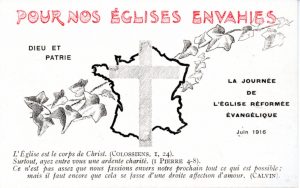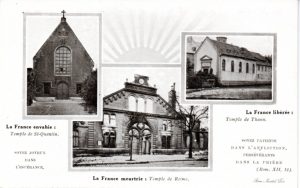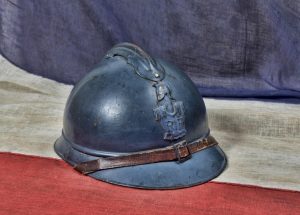The Protestants in the occupied zones
As early as September-October 1914, the German troops had already invaded North-Eastern France: they fully or partially occupied ten departments, from Nord and Pas-de-Calais to the Vosges departments.
Living under German military administrative rules was hard demanding, because German ordinances were strict, notably forbidding all communication under the threat of the death penalty with the free zones as well as occupied cities. The inhabitants were closely monitored by the authorities, and every trip had to be authorised.
Religious life was upset too as far away parishioners could rarely come to worship, German soldiers had to attend burials, and meetings, except for worship, were forbidden in temples.
Lay people participated more actively in religious life, for instance in Lille ‘lay worship’ took place as because the pastor was absent. Patriotic revival of the French Protestants increased, despite the religious or family bonds with the Germans. The war also brought Catholics and Protestants closer together in some places.
On several occasions during the conflict the German authorities ordered inhabitants to be moved from the occupied zone, pulling down Protestant buildings as well as homes.
Pastors in the occupied zones
Most pastors were called to the front, but a minority, those deemed unfit for military service or too old to be mobilized, remained in office. Thanks to the German chaplains’ actions, French pastors were granted permission to move around their worship places, but seldom to other Churches than their own.
Worship places were shared with the German occupant. Military chaplains and officers attended French worship more and more often. In several cities German chaplains had fir trees set up in temples for Christmas celebrations, but organised their own services. Sometimes temples were privatised with no warning, and used for specific celebrations, such as the Kaiser’s birthday for instance.
In June 1917 as the Germans were retreating and the relinquished territories abandoned, some pastors obtained the authorization of the return to France of a few hundred non mobilisable men, sick people, women and children. The French Protestant support committee for invaded territories, founded in 1915, then took charge of the refugees.
Reconstructing the Church
The Protestants in occupied zones had a similar fate to the rest of the French population. The consequences for the Protestant Church were terrible. Human consequences first: disappeared civilians were added to the toll of the fallen soldiers and many families were uprooted by evacuation. Then material consequences: as families as well as parishes lived in destitution. Temples were rebuilt or renovated between 1920 and 1925 often thanks to the generosity of foreign Protestant Churches. Spiritual reconstruction was launched by a new generation of pastors interested in evangelising the working class.



